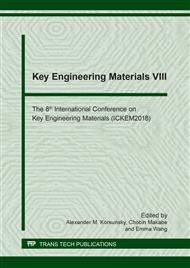[1]
S. Magdassi, M. Grouchko, O. Berezin, A. Kamyshny, Triggering the sintering of silver nanoparticles at room temperature, ACS Nano. 4 (2010) 1943-(1948).
DOI: 10.1021/nn901868t
Google Scholar
[2]
M. Layani, M. Grouchko, S. Shemesh, S. Magdassi, Conductive patterns on plastic substrates by sequential inkjet printing of silver nanoparticles and electrolyte sintering solutions, J. Mater. Chem. 22 (2012) 14349-14352.
DOI: 10.1039/c2jm32789a
Google Scholar
[3]
E. Datu, M. D. Balela, In situ electrochemical study of copper nanoparticles stabilized with food grade gelatin, Key Engineering Materials 705 (2016) 163-167.
DOI: 10.4028/www.scientific.net/kem.705.163
Google Scholar
[4]
M. D. Balela, K. L Amores. Formation of oxidation-stable copper nanoparticles in water. Adv. Mater. Res. 1132 (2016) 255-259.
DOI: 10.4028/www.scientific.net/amr.1131.255
Google Scholar
[5]
M. Tan, L. de Jesus, K. L. Amores, E. Datu, M. D. Balela. Electroless deposition of copper nanostructures in aqueous solution, Adv. Mater. Res. 1043 (2014) 114-118.
DOI: 10.4028/www.scientific.net/amr.1043.114
Google Scholar
[6]
W. Cui, W. Lu, Y. Zhang, G. Lin, T. Wei, L. Jiang. Gold nanoparticle ink suitable for electric-conductive pattern fabrication using ink-jet printing technology, Colloids and Surfaces A Physiochemical and Engineering Aspects 358 (2010) 35-41.
DOI: 10.1016/j.colsurfa.2010.01.023
Google Scholar
[7]
D. Huang, F. Liao, S. Molesa, D. Redinger, V. Subramanian. Plastic-Compatible Low Resistance Printable Gold Nanoparticle Conductors for Flexible Electronics, J. Electrochem. Soc. 150 (2003) G412–G417.
DOI: 10.1149/1.1582466
Google Scholar
[8]
D. Corsino, M.D. Balela. Room temperature sintering of printer silver nanoparticle conductive ink, IOP Conf. Ser.: Mater. Sci. Eng. 264 (2017) 012020.
DOI: 10.1088/1757-899x/264/1/012020
Google Scholar
[9]
N. De Guzman, M.D. Balela. Formation of silver nanowires in ethylene glycol for transparent conducting electrode.
Google Scholar
[10]
J. S. Kang, J. Ryu, H.S. Kim, H.T. Hahn. Sintering of inkjet-printed silver nanoparticles at room temperature using intense pulsed light, J. of Elec. Mater. 40 (2011) 2268-2277.
DOI: 10.1007/s11664-011-1711-0
Google Scholar
[11]
N. De Guzman, M.D. Balela. Growth of ultralong Ag nanowires by electroless deposition in hot ethylene glycol for flexible transparent conducting electrodes, Journal of Nanomaterials 2017 (2017) 14 pages.
DOI: 10.1155/2017/7896094
Google Scholar
[12]
E. Tekin, P. J. Smith, U. S. Schubert. Inkjet printing as a deposition and patterning tool for polymers and inorganic particles, Soft Matter 4 (2008) 703–713.
DOI: 10.1039/b711984d
Google Scholar
[13]
L. Rapp, J. Ailuno, A. P. Alloncle, P. Delaporte. Pulsed-laser printing of silver nanoparticles ink: control of morphological properties, Opt. Express 19 (2011) 21563–21574.
DOI: 10.1364/oe.19.021563
Google Scholar
[14]
T. H. J van Osch, J. Perelaer, A.W.M. de Laat, U.S. Schubert. Inkjet printing of narrow conductive tracks on untreated polymeric substrates, Adv. Mater. 20 (2008) 343–345.
DOI: 10.1002/adma.200701876
Google Scholar
[15]
S. Sivaramakrishnan, P.J. Chia, Y.C. Yeo, L.L. Chua, P.K.H. Ho. Controlled insulator-to-metal transformation in printable polymer composites with nanometal clusters, Nat. Mater. 6 (2007) 149–155.
DOI: 10.1038/nmat1806
Google Scholar
[16]
D. Kim, S. Jeong, B.K. Park, J. Moon. Direct writing of silver conductive patterns: Improvement of film morphology and conductance by controlling solvent compositions, Appl. Phys. Lett. 89 (2006) 264101.
DOI: 10.1063/1.2424671
Google Scholar
[17]
J. Perelaer, B.J de Gans, U.S. Schubert. Ink-jet printing and microwave sintering of conductive silver tracks. Adv. Mater. 18 (2006) 2101–2104.
DOI: 10.1002/adma.200502422
Google Scholar
[18]
S. Joo, D.F. Baldwin. Performance of silver nano particles as an electronics packaging interconnects material. Elec. Comp. C (2007) 212–226.
DOI: 10.1109/ectc.2007.373801
Google Scholar
[19]
M. Layani, S. Magdassi. Flexible transparent conductive coatings by combining self-assembly with sintering of silver nanoparticles performed at room temperature, J. Mater. Chem. 21 (2011) 15378–15382.
DOI: 10.1039/c1jm13174e
Google Scholar
[20]
M. Grouchko, A. Kamyshny, C.F. Mihailescu, D.F. Anghel, S. Magdassi. Conductive inks with a built-in, mechanism that enables sintering room temperature, ACS Nano 5 (2011) 3354-3359.
DOI: 10.1021/nn2005848
Google Scholar


